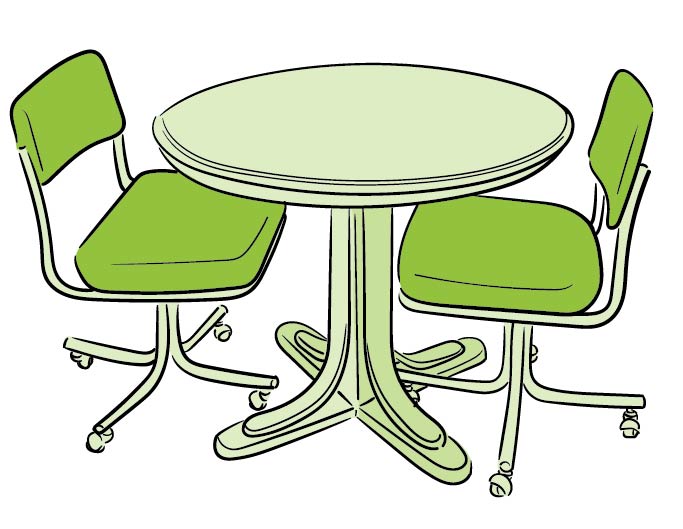FEATUREs:
- Occurs in the fall
- Involves five to ten vintage tables per week
- Is popular on Twitter
A few months ago my boyfriend and I moved to a small town and a bigger apartment, and we had to get some new furniture. I had been told the area we moved to is great for vintage; I had been told that the finds we would find would make everyone in New York City who buys their midcentury modern at a ridiculous markup feel shame and self-doubt. Good, I thought, remembering all the exorbitant and un-transportable teak I’d coveted the last time I’d had to buy furniture. I didn’t realize I would soon be punished for my vengefulness.
Things started off well. Knowing that vintage shopping is a matter of both perseverance and timing, I began going to the vintage stores near our house a few times a week. When I wasn’t at the vintage stores, I checked their Instagram accounts and scoured Craigslist multiple times a day. Did it get a little extreme? Maybe. But I’m an ardent procrastinator, and having something productive to spend my time on that was not work was invigorating. (This is why people bake.) I also suffered from the delusion that doing work was impossible until I could achieve a sense of completeness re: my environs.
(This is why people clean.) Soon enough, a dresser was acquired from a perfunctory psychotherapist. A couch was torturously researched and purchased. Plants were repotted and positioned for optimum light. “Look at our house!” I kept saying. “Our house is really nice!”
But this was not exactly true: it would not be really nice until we got a new kitchen table. We already had a small IKEA table, but our new kitchen is large and suitable for guests, and we wanted one we could work at luxuriously, with tons of things spread out on it. A nice, normal table like this seems like it should be much easier to find than a couch or a dresser, does it not? It’s not exactly a marquee item. But our previous victories had made us cocky. Progress stalled.
I had never thought about tables before. It was like the time I realized I needed to totally overhaul my approach to footwear, so I was constantly studying people’s shoes. (My conclusion: most people wear ugly shoes.) All the tables I encountered in the world seemed natural, at ease, unselected, acquired through some kind of convenience or luck—it seemed it was not possible to just waltz up and buy one, though I became fixated on doing just that. This is the devil’s bargain of vintage shopping: what you gain in money and precious originality you lose in time, which is soul and also money. My phone filled up with pictures of tables that were not quite right. Every time I saw other cars in the parking lot of the best local vintage store, I felt a flash of panic, imagining the right table had just been purchased out from under me, and I would walk in to see a red sold sign chastising me for not getting there earlier.
One day I was feeling bereft during one of my visits when an employee asked if she could help me. If she recognized me as the woman who slipped in quietly every other day and looped single-mindedly around the place in five minutes, she didn’t let on. Wearily, I told her I was looking for a table.
She seemed positively happy. “It’s about to be—well, we call it ‘table season,’” she said, as if she were sharing a secret that was just a little bit naughty. “In a week or two we’ll be getting in five to ten tables per week.”
The flood of relief I felt drowned out the many legitimate questions I should have asked. Five to ten tables per week? There was no way I wouldn’t find the table I wanted. Oh, great, I told her—I would see her very soon, then!
But by the time I got home—it’s about a seven-minute drive—something seemed off. How could such a thing be true? What was the engine of the supply? These are vintage tables, so it couldn’t be about the production schedule for new tables.
I posted a version of this story on Twitter, where everyone thought it was an absolute scream. Jokes about the annual table harvest abounded. A pun was made about the turning of leaves, which tables also have. A few people offered earnest possible explanations. It was the end of summer; therefore, something to do with college students moving in? Something to do with the end of estate and yard sale season? Something to do with Thanksgiving?
It was something to do with lies. Weeks passed, and there were no more tables at the vintage store than there had been. In fact, there may have been fewer.
I knew from experience that the fire that burns for new furniture must be constantly fed, so it was to my horror that I began to see my current table, previously an embarrassment and a scourge, as not that bad—an interesting shape, a sturdy base, not big enough to really have people over for dinner but not incompatible with our super-weird kitchen, either. The kitchen has black walls and cabinets, painted unevenly and with the wrong type of paint; the russet tile on the countertops is, we’re pretty sure, actually floor tile; the backsplash is teal; the wood floors are stained dark badly. There are double doors with crystal doorknobs and windows that are more than one hundred years old. A nicer table would probably transform what we currently see as warmly quirky into resentment. If only I could Instagram this space! I would cry, looking at the nice table that doesn’t belong here. This is a stark representation of class! I would never Instagram my space, but I would like to know I could. Being able to Instagram something and not doing it is, after all, the starkest representation of class there is.
A visiting friend made matters worse. This friend knows more about architecture and furniture than anyone else in the world. “I like the IKEA!” he said, walking appraisingly into our super-weird kitchen, and he wasn’t joking at all; among his infinite resources is a deep knowledge of which IKEAs are worth buying for reasons of both design and longevity. “I use the same one for work-from-home!”
Here is the point in the essay where I must consider: What does a table mean? If I were a women’s magazine or a home decor influencer or just a sentimental person, I would say it means gathering, friendship, family, community. If I were British, I would say that, when used as a verb, it means the opposite of what it means to an American. There are so many tables in art and history. The Last Supper table. King Arthur’s Round Table. The Algonquin Round Table, which only sort of refers to a literal table. The Fox sisters—nineteenth-century Victorian spiritualists—had a table rigged to allow them to create the illusion of the dead communicating through it. It would take years for me to find the table to teach me a valuable moral lesson about my search for a table. Even Marx’s commodity table, which “develops out of its wooden head caprices which are much more wondrous than if it all of a sudden began to dance,” is not, I’m sorry to say, especially relevant to me, even considering the hypothetical Instagram posting.
One day, at what should have been the height of table season, I tentatively approached another employee at the same vintage store. “This is a strange question,” I began, “but a few weeks ago another person who works here mentioned that it was about to be… table season? Can you tell me… why?”
“Oh, that must be Sandy,” she replied. “Usually we get a lot of tables in because people get excited to have people over, for the holidays, you know.” She seemed wise and a little sad. “But I don’t know if it’s going to happen this year.” I still had questions, but I now saw they didn’t matter. Life is all about context. In American English, the verb to table means to postpone or set aside.






